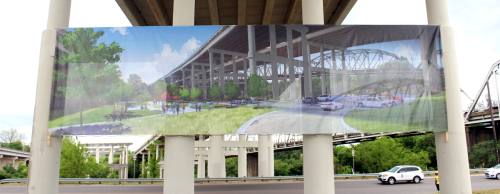The project also represents a significant connection to a part of Austin that Travis County Commissioner Margaret Gomez said historically has been neglected. The Montopolis Bridge spanning the Colorado River has helped bridge the gap between East Austin neighborhoods and the rest of the city, she said.
“Over time that connection has become more important to all of us,” she said. “East Austin has experienced an economic boost, and it remains critical that we acknowledge the history that once divided it from the greater Austin area and turn our attention to a future that establishes that connection in a more permanent way.”
Representing a partnership between the Central Texas Regional Mobility Authority and the Texas Department of Transportation, the 183 South project broke ground April 6.
Construction will begin in May on the $743 million project, which will include building three tolled lanes in each direction on US 183 between Hwy. 290 and SH 71 and also include three nontolled lanes in each direction with bike lanes and a shared-use path.
Five cross streets will be removed at 51st Street, Technicenter Drive, Bolm Road, Vargas Road and Thompson Lane. New turnarounds will be added between Loyola Lane and Bolm and at Patton Avenue. Mobility Authority Executive Director Mike Heiligenstein said this decision will make it faster for drivers trying to access US 183.
“We were very clear that we think the project would be safer and serve everyone’s interests better if we consolidated some of the intersections,” he said. “… People who turn right don’t have to stop. They have to go down a little bit and around so they won’t have an intersection to wait through.”
The first phase of the project between Hwy. 290 and Techni Center Drive is anticipated to be finished in 2019 with full completion of the project in 2020.
“Today we start another project where one of the main gateways to our airport will be opened up,” state Sen. Kirk Watson, D-Austin, said. He added that the SH 71 express project under construction from the airport to SH 130 is another key access to ABIA.
The project also will be vital when TxDOT begins construction on I-35, Watson said.
“When we get to the really, really hard part on I-35, which is in downtown Austin, we need to have a way to get people around downtown,” he said. “One of the best ways is going to be this roadway right here.”
Jeff Austin III, a member of TxDOT’s governing board, the Texas Transportation Commission, said the state Legislature has provided a lot of resources that allow public-private partnerships.
“We need another north/south roadway that can help relieve congestion,” he said. “… There’s not enough money to really put I-35 in a pain-free manner to relieve congestion immediately. It’s going to take a lot of other ways to move traffic. We have to find other routes. 183 is one of those routes.”
 Several local elected officials from the city of Austin and Travis and Williamson counties attended the April 6 ground breaking of the 183 South project.[/caption]
Several local elected officials from the city of Austin and Travis and Williamson counties attended the April 6 ground breaking of the 183 South project.[/caption]Lessons learned
183 South will use the same design/build process as used on the MoPac Improvement Project, Heiligenstein said. However, the agency revamped the process to avoiding having similar issues and delays.
“We’ve got to be more engaged in that phase, in the first six months in particular, and really doing better oversight of what they’re doing in the shop,” he said. “… We’ve learned we need to have a much more hands-on approach.”
Design/build permits construction to begin before the design is completed. He said the agency also selected the second-lowest bid to pay $120 million more not to have similar timeline issues as on MoPac.
Key collaboration
183 South was not always envisioned to have a toll component, but TxDOT faced issues with trying to fund the project, said Terry McCoy, Austin district engineer for TxDOT. That is when the Mobility Authority stepped in to take on the project as a toll road.
“Having a toll element allows us to accelerate that construction and accelerate the delivery of the project,” McCoy said.
The Mobility Authority has no taxing authority but finances most of its projects through revenue bonds, which may also be spent on bicycle and pedestrian improvements.
McCoy said TxDOT has a staff of three that regularly meets with the Mobility Authority on projects.
“The partnership between the RMA and TxDOT, you’re seeing it today, but it happens every day,” he said.
Bike/ped improvements
The historic Montopolis Bridge was first built by Travis County in the 1880s but was destroyed by floods in 1935, Gomez said. The truss bridge was rebuilt in 1938 and has been on the National Register of Historic Places since 1996, she said.
The bridge will be decommissioned to vehicular traffic, Heiligenstein said, and converted for use by bicyclists and pedestrians.
“I’m already telling everybody it’s going to be a farmers market on Saturdays, but it will be for pedestrians and bikes and reconnect a lot of what’s going on over here with the Lance Armstrong trail and other bicycles [facilities] and sidewalks,” Heiligenstein said. “It’s an important cog in the system.”
About $25 million will be invested in bike/ped improvements, which also include a seven-mile shared-use path on the northbound side of US 183, nine miles of sidewalks and 16 miles of bike lanes on both sides of the corridor. A new pedestrian bridge will be built near Manor and Springdale roads.
[g-carousel gid="143759" height="200" per_time="3"]





